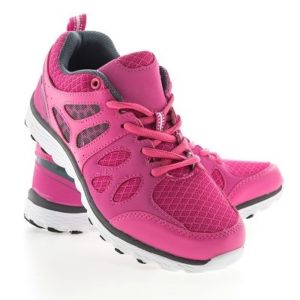 Men and women are different – and that applies to their different physiological needs for athletic shoes. Biomechanically, men and women are different in the way that their femurs insert into the hips, the angle of the knee and the way that their feet strike the ground. Each of these factors plays a role in how weight is distributed during walking or running.
Men and women are different – and that applies to their different physiological needs for athletic shoes. Biomechanically, men and women are different in the way that their femurs insert into the hips, the angle of the knee and the way that their feet strike the ground. Each of these factors plays a role in how weight is distributed during walking or running.
The walking shoes you buy will be different from the ones you may use for running because the mechanics of running is also very different from walking. The build, features and design of the shoe should be matched to the purpose.
As you walk your weight first strikes the ground through the heel and then rolls through to the ball of the foot, which is different from running where the weight often strikes first through the center of the foot or the ball of the foot.
It is very important to choose a shoe that provides support, durability and comfort – whether you are walking in the urban jungle or trail walking. Most manufactures have included materials that absorb moisture well, enhance breathability of the shoe and mold to your specific foot type to help prevent injuries.
Let’s examine what factors should be present in walking shoes designed for women.
The sole of the shoe should keep you stable, while the fabric is breathable and washable. There is no one shoe that is best for all women, but what is best for you is what fits you the best. Since each persons foot is different, you’ll also want a shoe that gives you the proper support and compensates for any problems with your stride you may – like under or over pronation.
The shoe you choose should be flexible. Pick it up and try to bend and twist it in your hands. When you are walking your foot is rolling through many bones, tendons and muscle – if the shoe is not flexible your foot will pay the price in injury and an increased risk of plantar fascitis.
If you need motion control in the shoe because of biomechanical issues you’ll have to sacrifice flexibility for control.
Walking shoes should have a relatively flat heel and not a raised heel. Save the shoes with a raised heel – to accentuate your calves – for your casual attire. Your legs will look great in shorts and your feet won’t be complaining through your walking.
The heel of the shoe should not be flared, as they are in running shoes. A flared heel will provide resistance to the foot as it strikes the ground at the heel and then rolls forward through the step. A true walking shoe will have an undercut heel.
Walkers will impact the ground with 1.5 times their body weight with each step. While this is less than runners who impact with 3 times their body weight, cushioning is still important to prevent injuries to the knees. Fitness walking shoes can be lighter weight with less cushioning than running shoes, especially in the forefoot.
RESOURCES
Staffordshire University: Gender Differences in Foot Shape
Medical Science Sports and Exercise: Gender Differences in Adult Foot Shape






